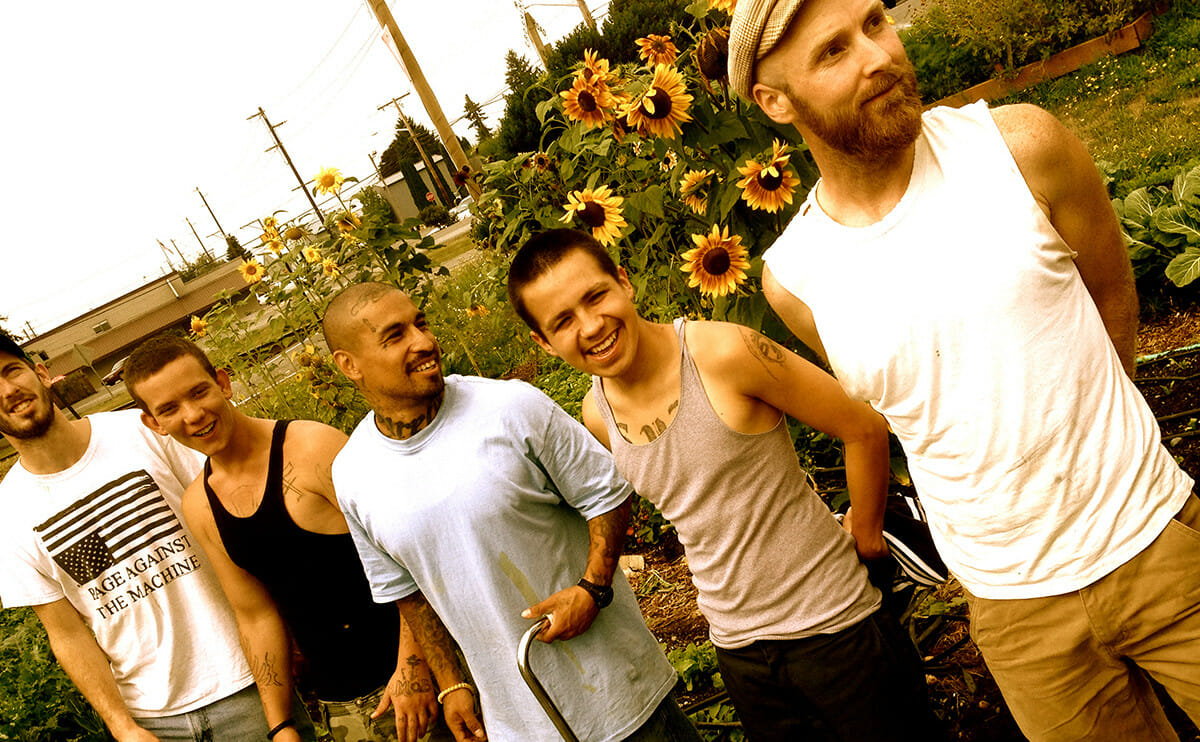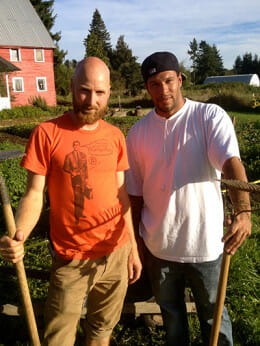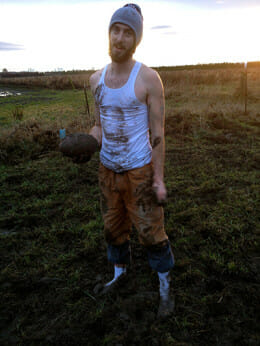Gangsters, Swastikas, Tweakers and Permaculture
This beautiful, sprawling permaculture garden is run by guys who met in jail or on the streets.
Gangsters, Swastikas, Tweakers and Permaculture
This beautiful, sprawling permaculture garden is run by guys who met in jail or on the streets.

“Do we hafta do shmarden hours today?” one of the guys in our drug and alcohol recovery home complained when we first started the garden.
This skinny young man in his early twenties, with a pale shaved head and big ungroomed beard – who, for the purposes of this story, asked to be called “Doctor Drangus” – had spent the last two years, before detoxing and starting his recovery, on the streets of our Skagit Valley here in rainy Northwest Washington. He slept inside clothing donation bins at gas stations and tweaked out on crystal meth in the forest. He’d spend days in the woods carving sticks into little figurines with bugged-out eyes, squatting with a hunting knife, paranoid of all the noises he’d hear in the trees.
When we designed a permaculture-style garden this last year, we had lofty visions. Our organization works with migrant farmworkers and folks we meet in the jail where we visit as regular chaplains. We seek out and serve the people society uses up or throws away – deporting them or locking them up in social dumpsters.
We already had the gang and drug recovery home, but this new garden would be a site of healing, healthy work in the soil, reconciliation with the natural world after years of trauma, drugs, violence and prison cells. Back to nature. Wendell Berry kind of stuff.

But Doctor Drangus would roll his eyes when hearing anyone on staff use the word “therapeutic.” He wasn’t buying it, these mandatory hours double-digging soft garden beds with us, sifting compost, planting comfrey around the plum tree. He had no patience for talk of plant diversity, symbiosis, or the art of building interconnections between different plant species. He’d find excuses to wander off, smoke a cigarette, disappear for an hour and come back from the corner store with a bag of energy drinks.
Larry, our garden director, a gentle and soft-spoken young man, was better at putting the plants in order. He arrived here from North Carolina, with a distinct Southern drawl not natural to these parts, after a cross-country spiritual quest on the back of an old Honda Nighthawk.
When it came time to corral workers into the garden, though, he’d stare at the soil with his deep brown eyes, twist his wieldy orange beard and begin explaining the subtleties of the day’s project… and you never quite heard the end of his sentences. They’d always taper off into contemplative silence. “Yeah, so…”
So the guys in the recovery home would light cigarettes and wander off. They weren’t catching the vision. Larry would end up working alone, humbly, out there among the sunflowers and tomatoes.
A lot of this changed when Neaners came home from prison.
Neaners was in solitary confinement at a maximum-security facility, doing seven and a half years for gang-related crimes in our valley, when he had the vision for this garden. In his mind’s eye, he envisioned a “lil’ farm with flowers and pigs and animals ‘n shit” where “homies can kick back in their chanclas [sandals]” and the “unloved and wanted” could make meals, sing, plant vegetables and “be in a lovin’ kinda place.” His prison letters, mailed to us, were the garden’s inspiration.
Neaners was in solitary confinement, inside a maximum-security facility, doing seven and a half years for gang-related crimes in our valley, when he had the vision for this garden.
So, in a sense, this Mexican gang leader with tattoos down his cheeks, deep inside a neon-lit cinderblock box 23 hours a day, was the garden’s founder. This summer, he came home. And got to work on the garden Larry had faithfully begun to build off of his prison-letter blueprint.
Neaners, with a mix of temper, charm and hustle, quickly put Doctor Drangus in check. As a former gang leader, he knew how to not just lead by example, but how to motivate others, give out orders, and get people to “put work in.”
The complaining stopped. Hard work — and laughter — increased among the guys.

Our glossy handbook describes permaculture as “a dynamic interplay of order and chaos, entropy, tidiness, control, and creativity.” It encourages garden designers to build “close associations of different species around a central element,” whose intentional placement allows wildly different plants – as opposed to mile-long rows of one crop – to “benefit each other.”
Though we’re still far behind in building such plant guilds, I’m starting to see those principles play out with the human ecology in our garden. It’s like how Neaners’ street leadership skills partnered well with Larry’s quiet gardening brilliance. What’s that, if not symbiosis?
I look at Taylir, one of the new white kids in the crew, hacking away today at the roots of an old dead tree we’re trying to pull out of the ground. Taylir hated Mexicans all his young life. His uncles approved of the giant swastika tattooed on the center of his chest, and the smattering of WPs (for White Power) etched around his neckline and coming down his pale arms. He was taught to stick with his own kind.
The human connections I’m witnessing here, I suppose, defy that kind of monoculture: “Connect functional interrelationships across varying life kingdoms,” in surprising ways that “create harmony.”
So, now Taylir is working with a Mexican gangster in the garden – along with the three undocumented Mexican boys whom Neaners has led out of the projects. Now they tease Taylir, and throw nasty leaves at each other by the compost pile.
Neaners is scheming with Taylir to cover up that swastika on his chest with a new tattoo of a Sacred Heart. He’s hooking Taylir up with his tattoo artist buddy. “We gotchyou,” he assures.

Gangsters, tweakers, skinheads, “illegals,” sensitive hippie farmers, normies – there’s resonance when we are placed in the dirt together, away from our various isolations of prison cells, clothes bins, or bookstores. Like plants, we need each other.
Permaculture helps me see those deeper mysteries, even if we’re not cranking out braggable, edible produce yet. Most of the walnuts, for example, ended up rotting last month. The guys never finished raking them up from under the heritage tree – they found a crusty football and we ended up tackling each other in the frigid mud until dusk. When we were done, we emerged with our differing shoes, shirts, tattoos, skin colors, all covered with the earth, talking shit as trumpeter swans flew over our heads with the cold, magical sunset.
As in all experiments, surprises are bound to yield. Just this week, Doctor Drangus enrolled in local community college classes. The “nature shmature” former meth-head has chosen a major: environmental conservation.
Some names in this story have been changed by request.
Chris Hoke is a jail chaplain, gang pastor, and coffee roasting entrepreneur. His book WANTED: A Spiritual Pursuit Through Jail, Among Outlaws, and Across Borders (HarperOne, 2015) comes out Feb. 3.
Follow us
This work is licensed under a Creative Commons Attribution-NoDerivatives 4.0 International License.
Want to republish a Modern Farmer story?
We are happy for Modern Farmer stories to be shared, and encourage you to republish our articles for your audience. When doing so, we ask that you follow these guidelines:
Please credit us and our writers
For the author byline, please use “Author Name, Modern Farmer.” At the top of our stories, if on the web, please include this text and link: “This story was originally published by Modern Farmer.”
Please make sure to include a link back to either our home page or the article URL.
At the bottom of the story, please include the following text:
“Modern Farmer is a nonprofit initiative dedicated to raising awareness and catalyzing action at the intersection of food, agriculture, and society. Read more at <link>Modern Farmer</link>.”
Use our widget
We’d like to be able to track our stories, so we ask that if you republish our content, you do so using our widget (located on the left hand side of the article). The HTML code has a built-in tracker that tells us the data and domain where the story was published, as well as view counts.
Check the image requirements
It’s your responsibility to confirm you're licensed to republish images in our articles. Some images, such as those from commercial providers, don't allow their images to be republished without permission or payment. Copyright terms are generally listed in the image caption and attribution. You are welcome to omit our images or substitute with your own. Charts and interactive graphics follow the same rules.
Don’t change too much. Or, ask us first.
Articles must be republished in their entirety. It’s okay to change references to time (“today” to “yesterday”) or location (“Iowa City, IA” to “here”). But please keep everything else the same.
If you feel strongly that a more material edit needs to be made, get in touch with us at [email protected]. We’re happy to discuss it with the original author, but we must have prior approval for changes before publication.
Special cases
Extracts. You may run the first few lines or paragraphs of the article and then say: “Read the full article at Modern Farmer” with a link back to the original article.
Quotes. You may quote authors provided you include a link back to the article URL.
Translations. These require writer approval. To inquire about translation of a Modern Farmer article, contact us at [email protected]
Signed consent / copyright release forms. These are not required, provided you are following these guidelines.
Print. Articles can be republished in print under these same rules, with the exception that you do not need to include the links.
Tag us
When sharing the story on social media, please tag us using the following: - Twitter (@ModFarm) - Facebook (@ModernFarmerMedia) - Instagram (@modfarm)
Use our content respectfully
Modern Farmer is a nonprofit and as such we share our content for free and in good faith in order to reach new audiences. Respectfully,
No selling ads against our stories. It’s okay to put our stories on pages with ads.
Don’t republish our material wholesale, or automatically; you need to select stories to be republished individually.
You have no rights to sell, license, syndicate, or otherwise represent yourself as the authorized owner of our material to any third parties. This means that you cannot actively publish or submit our work for syndication to third party platforms or apps like Apple News or Google News. We understand that publishers cannot fully control when certain third parties automatically summarize or crawl content from publishers’ own sites.
Keep in touch
We want to hear from you if you love Modern Farmer content, have a collaboration idea, or anything else to share. As a nonprofit outlet, we work in service of our community and are always open to comments, feedback, and ideas. Contact us at [email protected].by Chris Hoke, Modern Farmer
January 21, 2015
Modern Farmer Weekly
Solutions Hub
Innovations, ideas and inspiration. Actionable solutions for a resilient food system.
ExploreExplore other topics
Share With Us
We want to hear from Modern Farmer readers who have thoughtful commentary, actionable solutions, or helpful ideas to share.
SubmitNecessary cookies are absolutely essential for the website to function properly. This category only includes cookies that ensures basic functionalities and security features of the website. These cookies do not store any personal information.
Any cookies that may not be particularly necessary for the website to function and are used specifically to collect user personal data via analytics, ads, other embedded contents are termed as non-necessary cookies.
Thanks i read the book and really enjoyed
m